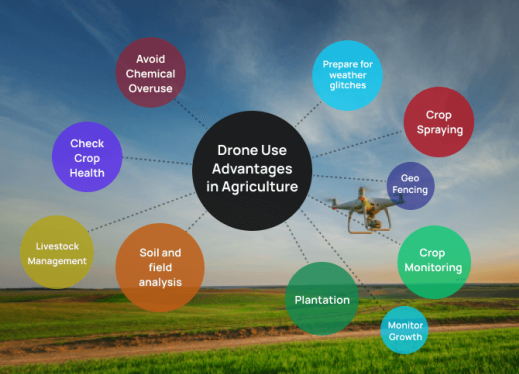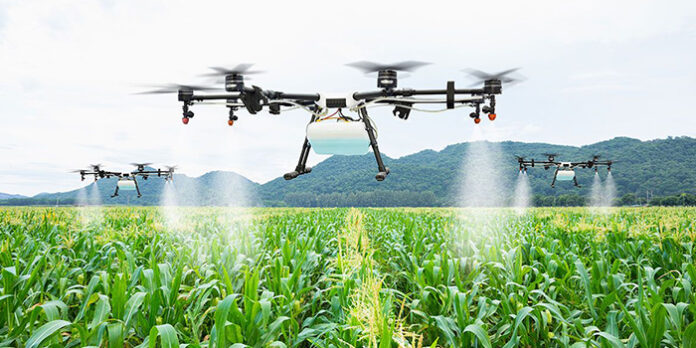The utilization of drones is rapidly expanding across various sectors of the economy, but it is particularly flourishing in the agricultural industry. The agricultural drone industry is projected to reach a staggering $4.8 billion by 2024. In just a few years, drone usage will become increasingly prevalent on both large and small farms, serving a multitude of purposes ranging from scouting to security. The valuable information collected by drones on farms is frequently employed to enhance agronomic decision-making, forming an integral part of the comprehensive system known as ‘precision agriculture’.

Drones are used for various practices in Agriculture such as, Use for monitoring plant health
One of the most successful applications of drone imagery thus far has been in monitoring plant health. Drones equipped with specialized imaging equipment, such as the Normalized Difference Vegetation Index (NDVI), utilize intricate color data to assess the health of plants. This enables farmers to closely monitor the growth of their crops, promptly addressing any issues that may arise in order to salvage the plants. Drones equipped with conventional cameras are also employed for crop health monitoring. While satellite imagery is already utilized by many of farmers to track crop growth, density, and coloration, it can be expensive and less effective compared to the closer imaging provided by drones.
Monitoring Field Conditions
Drone technology is revolutionizing the way to monitor soil health and field conditions. By utilizing drones, growers can obtain precise and comprehensive field mapping, including elevation data, enabling them to identify any anomalies within their fields. This invaluable information on field elevation aids in determining drainage patterns and identifying areas that are either too wet or too dry. Consequently, this knowledge empowers growers to adopt more efficient watering techniques, optimizing their irrigation practices. Some agricultural drones have new advanced technologies such as nitrogen level monitoring in the soil through advanced sensors. This cutting-edge feature allows for the accurate application of fertilizers, effectively eliminating poor growing spots and enhancing soil health for the future.
Use of drones in Planting & Seeding
The emerging and less commonly utilized application of drones in agriculture is seed planting. Currently, automated drone seeders are primarily employed in the forestry industry, but the potential for broader implementation is on the horizon. Utilizing drones for planting enables the reforestation of remote and inaccessible areas without putting workers at risk. Moreover, this technology allows for significantly enhanced efficiency, as a team of two operators and ten drones can plant an impressive 400,000 trees per day. These drones Not only eliminate the need for human labor in hazardous environments, but they also ensure the rapid and precise distribution of seeds.
Use in Spray Application
The use of drones for spraying is already widespread in Southeast Asia, with South Korea leading the way by employing drones for approximately 31% of their agricultural spraying. These drone sprayers possess the remarkable ability to navigate even the most challenging terrains, such as steep tea fields at high elevations. By doing so, they eliminate the need for workers to venture into these fields with backpack sprayers, which can pose health hazards. Moreover, drone sprayers deliver incredibly fine spray applications that can be precisely targeted to specific areas, thereby maximizing efficiency and reducing chemical costs. Yamaha, a manufacturer of spray drones, does not sell these drones directly but instead offers leasing services that include licensed operators.
Pollinator drones
The application of drones in agriculture is continuously evolving, with several innovative uses currently undergoing testing and development. Among these, the concept of pollinating drones has garnered significant attention, albeit often portrayed inaccurately. In the Netherlands and Japan, researchers are diligently working on the development of small drones specifically designed for pollination, ensuring plants remain unharmed. The ultimate goal is to create autonomous pollinating drones capable of independently operating and monitoring crop health, eliminating the need for constant human intervention.
Drones have already significantly transformed the agricultural industry and are expected to further expand in the years to come. It is crucial to establish and update regulations regarding drone usage in numerous countries, as well as conduct further research on their efficacy in specific tasks, such as pesticide application and spraying. The potential benefits of drones for farmers are vast and diverse. XAG, a leading smart agricultural technology company, forged a strategic partnership with FarmInno to introduce cutting-edge fully autonomous agricultural drones to Thailand in February 2023.
